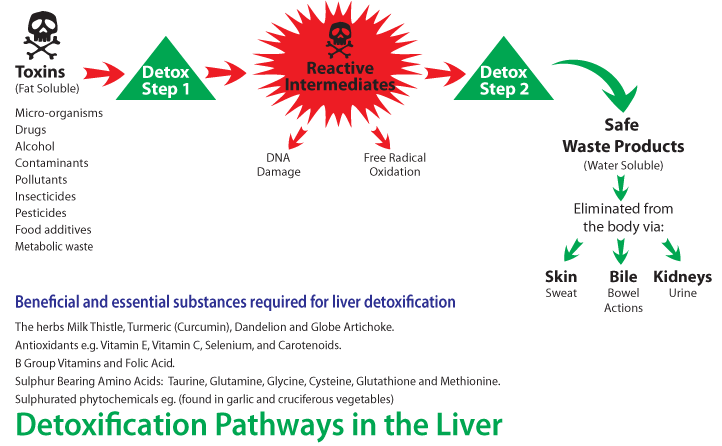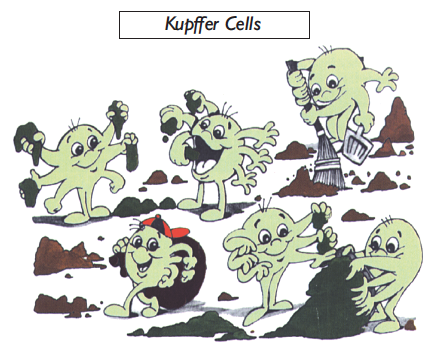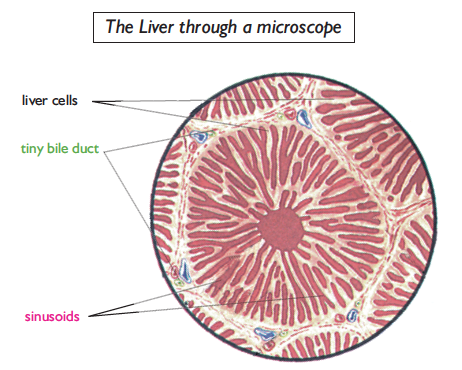
The Liver and Detoxification

The Liver Filter
The liver is the cleanser and filter of the bloodstream and is of vital importance. It is the largest organ in the body and has an enormous amount of blood flowing through it every minute of our lives. It is between 8 - 9 inches in its greatest diameter, 5 - 6 inches in its greatest height and 3 - 4 inches in its depth, weighing around 42 to 56 ounces.

A Normal healthy Liver
What are the functions of the liver?
- It is responsible for the production of bile which is stored in the gallbladder and released when required for the digestion of fats.
- The liver stores glucose in the form of glycogen which is converted back to glucose again when needed for energy.
- It also plays an important role in the metabolism of protein and fats. It stores the vitamins A, D, K, B12 and folate and synthesizes blood clotting factors.
- Another important role is as a detoxifier, breaking down or transforming substances like ammonia, metabolic waste, drugs, alcohol and chemicals, so that they can be excreted. These may also be referred to as "xenobiotic" chemicals. If we examine the liver under a microscope, we will see rows of liver cells separated by spaces which act like a filter or sieve, through which the bloodstream flows. The liver filter is designed to remove toxic matter such as dead cells, microorganisms, chemicals, drugs and particulate debris from the bloodstream. The liver filter is called the sinusoidal system, and contains specialized cells known as Kupffer cells which ingest and break down toxic matter.


The Liver Filter
The liver filter can remove a wide range of micro-organisms such as bacteria, fungi, viruses and parasites from the bloodstream, which is highly desirable, as we certainly do not want these dangerous things building up in the blood and invading the deeper parts of the body. Infections with parasites often come from the contaminated water supplies found in large cities, and indeed other dangerous organisms may find their way into your gut and bloodstream from these sources. This can cause chronic infections and poor health, so it is important to protect your liver from overload with these microorganisms. The safest thing to do is boil your water for at least 5 minutes, or drink only bottled water that has been filtered and sterilized. High loads of unhealthy micro-organisms can also come from eating foods that are prepared in conditions of poor hygiene by persons who are carrying bacteria, viruses or parasites on their skin. Foods, especially meats that are not fresh or are preserved, also contain a higher bacterial load, which will overwork the liver filter if they are eaten regularly.
Recently, it has become very fashionable for people to detoxify their bodies by various means, such as fasting or cleansing the bowels with fiber mixtures. Fasting can by its extreme nature, only be a temporary method of cleansing the body of waste products, and for many people causes an excessively rapid release of toxins which can cause unpleasant, acute symptoms. The liver filter, like any filter, needs to be cleansed regularly, and it is much easier and safer to do it everyday. This is easily and pleasantly achieved by adopting a daily eating pattern that maintains the liver filter in a healthy clean state. By following the methods and guidelines on this site, you will be able to keep the liver filter healthy and clean. Although it is important to keep the intestines moving regularly and to sweep their walls with high fiber and living foods, it is important to remember that the bowels are really a channel of elimination and not a cleansing organ per se. In other words the bowels cannot cleanse, filter or remove toxic wastes from the bloodstream. More than ever before in the history of mankind, human beings need to have healthy livers to break down the chemicals that have crept into our environment. If you talk to radiologists and gastroenterologists who are looking at people's livers today they will tell you that the condition "Fatty Liver" affects more than 50% of people over the age of 50! See Fatty Liver for more information. Common causes often include; incorrect diet, excessive alcohol intake, adverse reactions to drugs and toxic chemicals, and viral hepatitis. Dr. Cabot believes it is because modern-day medicine has become sidetracked into treating the symptoms of diseases and not the causes. Excess weight is a symptom of liver dysfunction and not solely due to the number of calories you consume. We have been attacking the symptoms of weight excess with fad diets, obsessive high impact aerobics, stomach stapling and toxic drugs, such as appetite suppressants, laxatives and diuretics. We have failed to consider the underlying cause of LIVER DYSFUNCTION and indeed we have virtually ignored the hardest-working organ in the body, with dire consequences. Dr. Sandra Cabot's books on the liver show us these consequences - not just weight problems, but a higher incidence of cardiovascular and degenerative diseases that are the leading causes of death in modern affluent societies. Dr Cabot received an email from a reader of her books and websites, who was alarmed by the large number of hormone implants being inserted into beef animals where she worked in a stock and station agency. Steers are implanted with Hormonal Growth Promotants (HGP) which is justified by corporate statements, that tests have shown that a non-pregnant woman produces 54,000 times the amount of estrogen found in a 17 oz steak and that only a fraction of the amount used in human hormone replacement therapy is used in the implants that are put into animals. This is all very well, however, it is still increasing the workload of the liver, which over a long period of time may cause hormonal imbalances in those who eat beef regularly. We must ask ourselves why is the incidence of breast cancer so high, particularly in relatively young women? Surely it is better to eat meat from animals that roam free and happy in fresh green pastures that are not injected with potent hormones or fed concentrated stock feed to rush their growth? The use of drugs to control and treat animal disease and to promote faster, more efficient growth of livestock is a common practice. An estimated 80 percent of U.S. livestock and poultry receive some animal drugs during their lifetime. Improper use of animal drugs may cause residues in the edible tissues of slaughtered animals that could be hazardous to consumers. Most countries will have set MRL or Maximum Residue Limits. This is the amount of pesticide residue, heavy metals, hormone residues and natural toxins that the food ( eggs, meat or milk) are allowed to have and still be sold to the public for consumption. The MRLs in Australia are set by the National Registration Authority for Agricultural and Veterinary Chemicals. In the USA they are set by authorities under the Food and Drug Administration. The key point is, just because a food substance complies in relation to the MRL , does not mean that the food is free from ALL contamination - just that it is at, or under, the level set by the particular authority deemed to be safe. MRLs are often set on a national basis to meet the requirements of a particular country. However, pests and pest pressure can vary between countries, as can chemicals used and agronomic practices. The lists of MRL values applying in different countries can therefore be quite different. There is also the point that despite the existence of these laws, it does not guarantee that all farmers and growers comply 100% . Principle causes of excessive drug residues are failure to observe drug label withdrawal periods before slaughter or processing, or failure to withhold milk after dosing of herds with drugs such as the treatment of bovine mastitis with large doses of penicillin which requires a withholding period before the residues in milk are reduced to acceptable levels. Other causes may include failure to follow other drug label directions, poor feed manufacturing practices, and human negligence. There are many chemicals (e.g., trace metals, industrial chemicals, and mycotoxins) that may be inadvertently present in animal tissues yet have no established safe concentrations. This of course does not mean that these substances are not harmful. It is a fact of life that pesticides, herbicides and hormones are used in food production. Although the regulatory levels set by authorities provide some control over residues - it is not the 'be all and end all'. The liver is again highlighted as vital, as it is the organ that metabolizes these substances and excretes them from the body.It is only the liver that can purify the bloodstream and we only have one liver.
Toxins
Toxins in Food and the Environment
Pesticides
Pesticide is a term encompassing a wide variety of substances used in food production to control undesirable plant, insect, and other animal populations. These may include chlorinated hydrocarbon pesticides, organophosphates, plus others. Many factors influence the persistence of pesticide residues in or on food. Residues may vary depending on the time between application and harvest, exposure to wind, rain, or sunlight, and the amount removed during processing (washing, peeling or cooking). Residues of pesticides can be found in many foods including breast milk. Particular care in assessing the safety of exposure to pesticide residues needs to be exercised for pesticides which could be transferred from food into breast milk and result in a relatively high exposure level to babies, and also to those which leave residues in foods which may be consumed in relatively higher amounts by children.Anti-parasitics
Certain anti-parasitics are fat soluble and will therefore persist in the fat component of foods containing animal fats such as dairy products and the fatty parts of meat. This means that foods such as fatty meats, cheese, butter and other dairy products should be avoided when trying to lower the workload of the liver. Similarly, it is these fat soluble toxins that may be tucked away in our fatty deposits.Hormones
Hormones may be used to accelerate the growth rate of animals so that they can reach market earlier. They may also be used to improve or manage breeding programs. Natural and synthetic hormones are used. In some countries inadequate monitoring and education of the users of these hormones resulted in meat (both beef and chicken) and eggs to contain high levels of hormonal residues. This caused health concerns in the population consuming these foods including early puberty, breast development and ovarian cysts in young girls. Some scientists believe that the potential for hormones in food to cause metabolic and reproductive problems in humans needs further evaluation. Hormonal Growth Promotants (HGP) are in implants designed to slowly release small quantities of hormones from the ear of cattle to the tissues. The hormone is similar to natural hormone found in animal species and humans, or they mimic the effects of natural hormones. They can also act as hormone replacements for castrated animals (steers, spayed heifers). HGPs increase weight gain and the efficiency of food conversion in cattle.Use of hormones and growth promotants in Australia
Some HGP have been approved for use in Australia since 1979. The levels of these hormones in meat, milk, etc. are tested for in the Commonwealth Government’s National Residue Survey program. Australian authorities state that no growth promoting hormones are used in the rearing of chickens. Estrogens were once administered to young male chickens as a hormonal alternative to castration to produce sterile roosters, however this practise was banned in Australia in the early 1960s. Some antibiotics are used therapeutically if a chicken has some sort of disease that can’t be cured by normal methods. These are used under veterinary prescription. But antibiotics are used in products called digestion enhancers also known as growth promotants. What these antibiotics do is adjust the gut in the chicken so it gets rid of the unwanted bacteria, so the bacteria that aid the digestion of the chicken’s food can proliferate. They are used specifically for growth promotion.Use of hormones in the USA
Most of the beef raised in the United States today is produced with the use of hormones of some kind, which have been used for more than 40 years. Low levels of hormones, delivered through pellets placed in animal’s ears, are commonly used as growth enhancers. The arguments for using hormones in meat production are mostly economic. With hormones, conversion of feed into meat is more efficient, thus theoretically lowering producer’s costs. In the United States, there are six FDA-approved hormones: three naturally occurring hormones (estradiol, progesterone, and testosterone) and their synthetic surrogates (zeranol, melengestrol acetate and trenbolone acetate). There is an ongoing dispute on the subject of hormones used in cattle. The US government and beef growers associations maintain that the use of hormones as growth promoters is safe and has no adverse effect on human health. However In 1988, the EU (European Union) prohibited the use of oestradiol 17 , testosterone, progesterone, zeranol, trenbolone acetate and melengestrol acetate (MGA) for growth promotion in farm animals. This prohibition applies to Member States and imports from third countries alike. This had major implications for trade and has caused an ongoing dispute. As a result the United States has opposed the EU prohibition on the use of these hormones since its implementation.Use of hormones in dairy cattle in the US
BGH stands for Bovine Growth Hormone, a substance naturally produced by the pituitary gland of cows. It is otherwise known as Bovine Somatotropin (BST). The actual hormone injected into cattle is rBGH. R stands for recombinant and means that it is a synthetic version of the natural hormone. This hormone is marketed under the brand name “Posilac”. Monsanto is the only company that markets this hormone to the dairy industry. The U.S. Food and Drug Administration approved Posilac in 1993. The hormone is used to increase milk yields from the cow – however it can cause serious health concerns for the animal which can then affect its milk supply in other ways – namely increased udder infections leading to higher levels of pus and infective matter in the milk. Monsanto prints the following on the warning label on each package of the hormone: “Cows injected with Posilac are at an increased risk of clinical mastitis (which results in visibly abnormal milk). The number of cows affected with clinical mastitis and the number of cases per cow may increase. In addition, the risk of sub-clinical mastitis (milk not visibly abnormal) is increased. In some herds, use of Posilac has been associated with increases in somatic cell counts…Use of Posilac is associated with increased frequency of use of medication in cows for mastitis and other health problems…” Since 1993, there has been a National Drug Residue Milk Monitoring Program to test raw milk for the presence of antibiotics—but only for antibiotics in the penicillin (betalactum) family.Hormone use in dairy cattle in Australia
A number of hormonal products are commercially available for use in the improvement of reproductive performance of dairy cattle.Prostaglandin
This hormone is injected into the cow. Use: synchronization – to bring a group of heifers all into ‘season’ at once and improving fertility. This hormone can cause retained fetal membranes, ovarian cysts in the cow, infections of the uterus and induced abortion.Progesterone
Vaginal implants (CIDR®) and a system of ear implant and intramuscular injection (CRESTAR) are used in Australia. Only CIDR is registered in Australia for use in lactating dairy cows. Use: Synchronization of cows to all be on heat at once, improved conception rates, stimulating the breeding state in non-cycling heifers and cows.Gonadotrophin Releasing Hormone (GnRH)
Use: Improving conception rates. Commercially available GnRH products are either identical to the naturally occurring hormone or synthetic.Estrogen
Used for preventing conception.Corticosteroids
Use : Inducing calving, aborting calves, ovarian cysts – Corticosteroids may be used in cases of cystic ovaries that do not respond to other treatments.Bovine somatotrophin (also called rBGH)
Bovine somatotrophin is NOT used in Australia but is approved for use in dairy cattle in the US (see above) and several other countries for increasing milk production. (From Research Notes ” Hormone treatments for better reproductive performance” Dairy Research and Development Corporation).Antibiotics
This is a group of drugs approved for use in animals to stimulate growth and improve feed efficiency (so that less feed is required for growth), and also to reduce infection and stock loss. There is no doubt that antibiotics are used widely in the Australian livestock industry. The continuous in-feed use of antibiotics began in agriculture in the early 1950s, especially in the pig, poultry, cattle and aquaculture industries. They are administered to the animal via coating of feed grains, drenching, injection or addition to water. The use of antibiotics in food animals has been a human health concern since the 1970s when the American FDA first called for restrictions on antibiotics used in animal feed. Resistance of dangerous bacteria is proportional to use, therefore overuse of antibiotics in animals, especially as growth promoters, poses unnecessary dangers to human health via the food chain. Resistance to antibiotics is not harmful in itself, but it may create health hazards if humans become infected with a strain of micro-organism that cannot be controlled by available antibiotics. In other words, antibiotics not working against bacteria that they’ve managed to kill before.Recommended books
Recommended supplements
- Intestinal parasite cleanse
- Selenomune
- LivaTone® Plus Capsules/Powder
These statements have not been evaluated by the FDA and are not intended to diagnose, treat or cure any diseases.
Know someone who might benefit from this article? Share it!
Need Help?
1-888-75-LIVER
Monday to Friday, 9:00 am to 5:00 pm MST
100%
Satisfaction Guaranteed
If it’s faulty or wrongly described, we’ll replace it.










